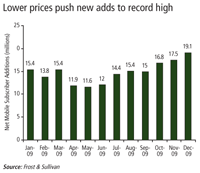 The Indian mobile market has long been a case study for managing massive traffic volumes largely through the use of outsourcing contracts. As far back as 2004 the country's largest mobile operator Bharti Airtel was engaging major telecom and equipment vendors to outsource its network management and IT operations.
The Indian mobile market has long been a case study for managing massive traffic volumes largely through the use of outsourcing contracts. As far back as 2004 the country's largest mobile operator Bharti Airtel was engaging major telecom and equipment vendors to outsource its network management and IT operations.
This practice was seen as essential to drive down costs and allow operators to become "minute factories" focusing largely on branding and marketing, and profitability continued to increase despite a falling ARPU. Therefore, it was not a serious concern if India already had one of the lowest effective mobile voice tariffs in the world and conversely one of the highest MOU rates especially given the vast growth opportunities that India offers in a market, which has just crossed the 50% SIM card population penetration threshold.
That theory is set to be put to the test, however, in a revitalized Indian market with unprecedented competition driven by new and newly-partnered mobile operators. India has always had a competitive market with local conglomerate-backed players such as Bharti Airtel, Reliance Communications, Idea Cellular, Loop Mobile and Ping Mobile competing among and against government operators BSNL and MTNL and the foreign players Vodafone and Maxis-backed Aircel. However, the Indian market is now home to many new operators such as MTS India backed by Russia's Sistema, Telenor's Uninor venture and Batelco-funded S-Tel.
Etisalat's DB operation will launch in early 2010, and white-goods manufacturer Videocon is in talks with Vivendi to acquire a stake in its mobile venture, meaning that the market will grow even more competitive. Furthermore, long-time player Tata Teleservices has rebranded itself as Tata DoCoMo following a 26% investment from the Japanese mobile operator and launching GSM service.
Unsurprisingly, these new operators have aggressively cut mobile voice tariffs even further in an attempt to gain a foothold in the market. Given the already competitive nature of the Indian market, the most recent round of price cuts have pushed Indian mobile tariffs to record-low levels.
For example, when Tata rebranded itself and launched GSM services it offered 1 paisa per second billing plans, which equals about $0.012 per minute, MTS India following suit with its own 50 paisa per minute rates ($0.011) and Uninor offered 29 paisa-per-minute rates (U$0.006) to coincide with its December 2009 service launch. These low rates have consequently caused the rate of subscriber adoption to accelerate, as the Indian mobile market added over 19 million subscribes in December 2009 alone.
